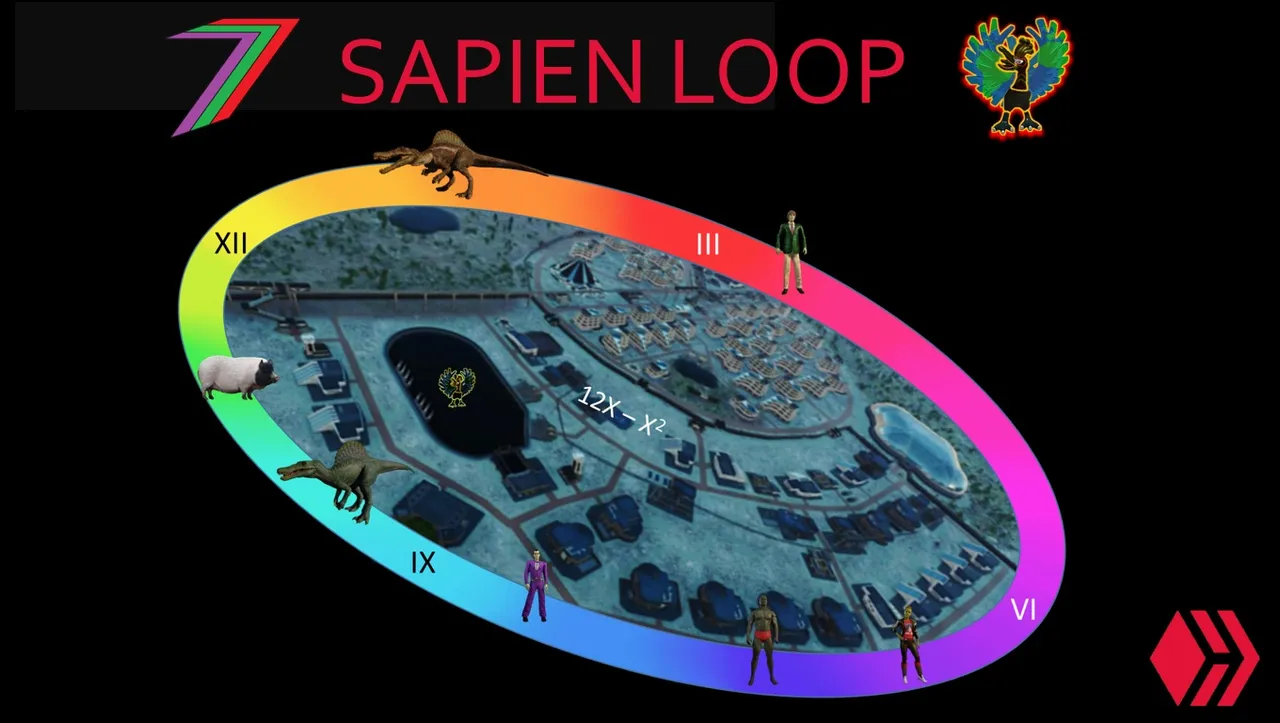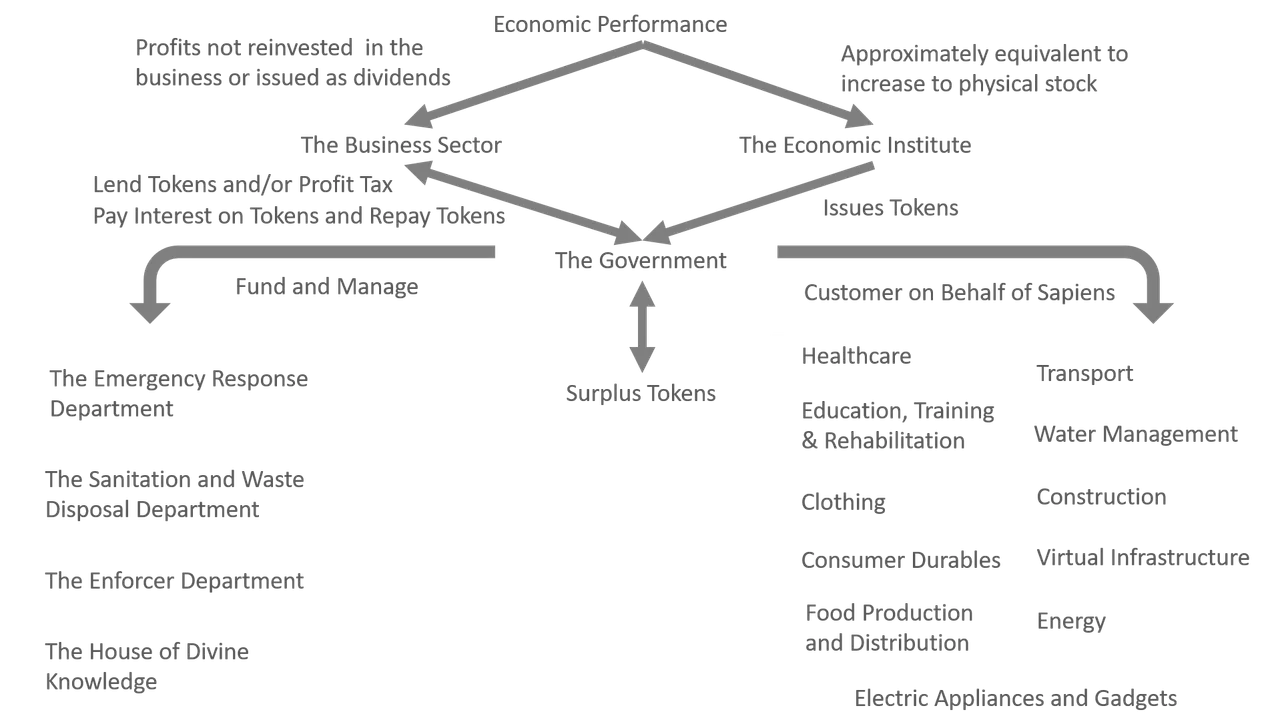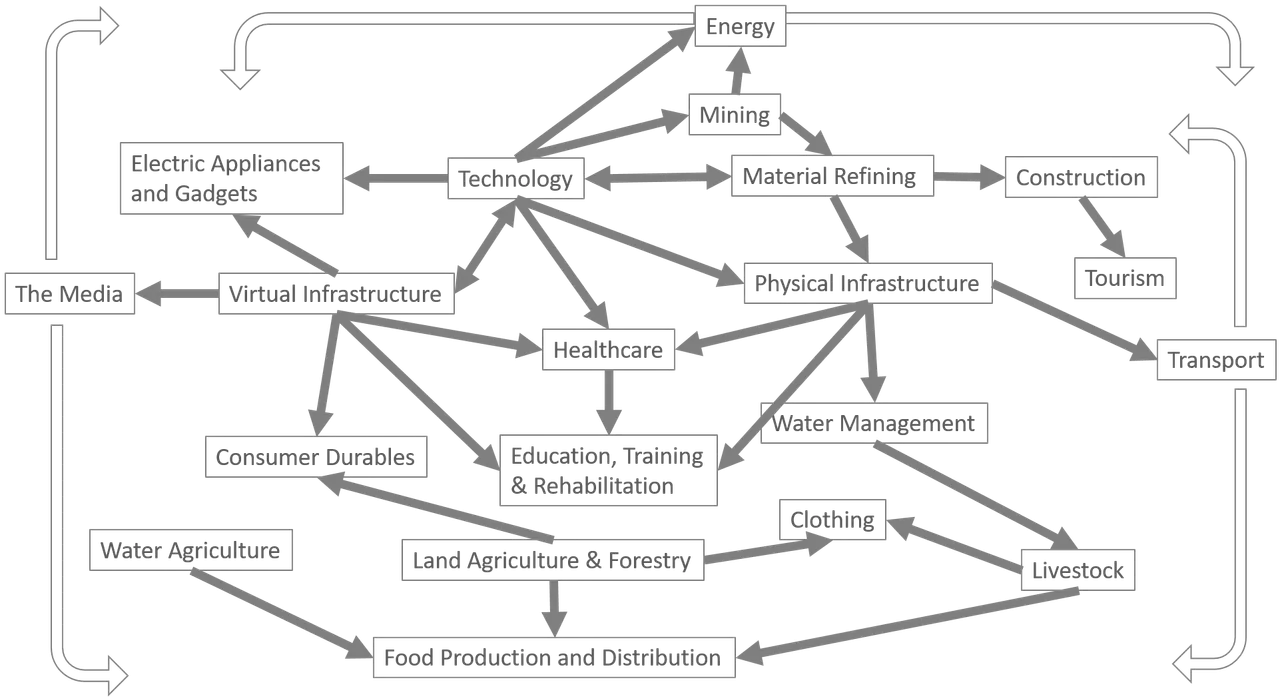
Chapter 2: The System

The Sapien system sounds unrealistic. Provision of everything cannot come from nowhere. It is impossible that everything can be free. To understand how their system worked, we need to understand efficiency and output. The Sapiens had very advanced technology. This technology enabled them to produce high quantities of output with minimal effort and time consumed by Sapiens.
The Sapiens would also exploit the Sapiods. They used them as a very cheap form of manual labour. They were able to produce a very high output at a very low cost.
Some of the necessary services were more labour-intensive but there were always more than a sufficient number of working Sapiens to fill these roles. Lack of output to meet the needs of all Sapiens was not a significant problem. A greater focus was placed on providing adequate incentives to enable a desirable distribution of output.
The Sapiens did not have a single system but a combination of systems that worked together to support their society. These systems had several areas of responsibility, such as the economy, governance, faith, and information.
These systems were represented by institutions and organisations. The institutions were the Economic Institute, the Government, and the House of Divine Knowledge. The two other systems were the Business Sector and the Media. These were made up of many privately owned organisations.
The systems were all dependent on each other in different ways. The systems were organised with the intention of preventing any Sapien, institute, or organisation from holding too much power. This enabled the distribution of the goods and services defined as ‘rights’ without the need for any direct fees or charges.
The Economic Institute
The Economic Institute was responsible for monitoring economic activity, productivity, efficiency, consumption, and growth. It tabulated and organised data to produce economic statistics. It presented them to the Government to enable them to make decisions and improve policy. The most significant role of the Economic Institute was the creation of tokens.
Tokens were a virtual currency issued by the Economic Institute to the Government. The Government used these tokens to pay for goods and services that fulfilled citizens’ ‘rights’. Businesses were the recipients of these tokens. The tokens were programmable and not transferable between non-business entities. The tokens were programmed by businesses.
The Government provided businesses with quotas on the types of programming they could use on the tokens. For example, 10% of tokens must be programmed for payment for additional energy costs for the home.
Tokens were paid to employees as rewards for work performed. They enabled employees to pay for and access ‘privileges’. ‘Privileges’ were provided by businesses. On receipt of the privilege, tokens were transferred to the business providing the privilege. Most tokens had an expiration date. If they were not used before that date, they would be returned to the Government. Once the tokens were paid to a business, the expiration date was removed. It was reapplied when they were paid out to employees.
The Economic Institute used information relating to the economy to determine how many new tokens to create. The formula for token creation was fundamentally supported by changes to the value of physical stocks held by businesses (similar concept to the gold standard used in our world). Normally, five or ten year averages were used to reduce the impact from years that had abnormally high or low changes to stock.
If the average change to stock was zero or negative, the Economic Institute did not issue any new tokens to the Government. Under these circumstances, for Government to make payments for operations and ‘rights’, they were expected to use their own reserves, collect more business tax revenue, or borrow from the Business Sector. To enable the Government to borrow from the Business Sector, the Economic Institute set an interest rate that would reward the Business Sector for lending the Government tokens.
Some tokens remained with the Economic Institute; this was for the purpose of covering operational costs. The Sapiens running the Economic Institute were referred to as financiers. Business owners from their own industry elected them from each industry from the Business Sector. Each industry had an equal number of financiers in the Economic Institute. Financiers were not allowed to interfere with politics. Token creation relied solely on economic rationale and not political ideology or pressure.
The Government
The Government determined the laws, policies, and token programming quotas. They funded the Emergency Response Department, Sanitation and Waste Disposal Department, Enforcer Department, and the House of Divine Knowledge. The Government was funded by the Economic Institute’s issued tokens, the Business Sector tax revenue, and borrowing from the Business Sector.
The Government was made up of governors and representatives. Representatives elected governors annually. Representatives were elected quadrennially (every four years) by Sapiens residing in each region. Two representatives represented each small region, and four representatives represented each large region.
There were no political parties. All representatives could be considered independent. However, most representatives supported one of the two dominant political ideologies. They were the pro-economic and the pro-social ideologies.
Representatives who aligned themselves with the Business Sector supported the pro-economic ideology. They favoured promoting economic activity and efficiency. They favoured borrowing from the Business Sector over business tax. They favoured programming tokens to support economic and technological development. They were in favour of fewer ‘rights’ and more ‘privileges’. The candidature of these representatives was typically funded by businesses and promoted by the media.
Representatives who aligned themselves with the House of Divine Knowledge supported the pro-social ideology. They favoured wellbeing and social cohesion. They favoured programming tokens to support social causes. They were in favour of more ‘rights’ and fewer ‘privileges’. They were also more likely to support higher taxes from the Business Sector to maintain higher expenditures for the departments run directly by the Government. The House of Divine Knowledge typically promoted the candidature of these representatives.
Government Controlled Departments
The Emergency Response Department was responsible for reaching onsite emergencies. They rescue trapped or injured Sapiens and they transfer them to medical facilities. They were responsible for putting out fires and responding to any form of disaster. The Sanitation and Waste Disposal Department was responsible for collecting, recycling, and disposing of waste around regions. They transported waste out of regions from disposal areas in the wastelands.
The Enforcer Department was responsible for maintaining law and order in the regions. They had the authority to detain Sapiens who were suspected of breaking the laws. The Sapiens were detained while the Head Enforcers determined innocence or guilt. If found not guilty, Sapiens were immediately released back to their region. If found guilty, they were assessed for a rehabilitation course. They were released once they had been determined to no longer pose a threat of reoffending. Enforcers were also responsible for preventing and stopping any form of uprising or social unrest in the regions. Prior to this story, this part of the job had not been necessary.
The House of Divine Knowledge
In Sapey, religion and philosophy were intertwined. The House of Divine Knowledge was where theologists and philosophers discussed and debated topics of deemed importance.
The theologists focused on information found in ancient scriptures. They discussed desired Sapien behaviour based on these scriptures. They discussed how behaviour in life affects what happens to the soul in the afterlife.
The philosophers referred to both ancient scriptures and modern theories. They believed knowledge and practices could be expanded based on real-world observations.
Theologists and philosophers held weekly lectures and sermons for the masses. They shared their knowledge and teachings directly with the Sapiens. They authored books explaining their findings (philosophers) or offered interpretations and applications of scripture (theologists). They organised events to help the less fortunate, the disabled, the sick, and the weak. They encouraged Sapiens to be kind and caring towards each other. They also emphasized the importance of obedience to authority. They taught that authority existed for the purpose of helping each other.
The House of Divine Knowledge was funded directly by the Government. However, it also received funding from some of the businesses as well as from private donors. Sapiens were allowed to donate their tokens regardless of programming. The tokens could be deprogrammed for the House of Divine Knowledge to use as they pleased.
The Media
The media consisted of entertainers and journalists. Entertainers had the main role of providing entertainment to the Sapiens. They consisted of actors, dancers, musicians, singers, athletes, writers, and comedians. The journalists had the main role of providing information about the most important and relevant events taking place in the region and the country. Each region had local broadcasts as well as national broadcasts. Some top entertainers and journalists were allowed to earn tokens that did not have expiration dates.
The media were funded by businesses that relied on Sapiens to use their tokens to buy their products. Businesses that typically funded the media were hotels and holiday resorts, clothing companies, producers of consumer durables, and electric appliances and gadget manufacturers. The Government and the House of Divine Knowledge sometimes sponsored various programmes promoting their ideologies or campaigns.
The Business Sector
The Business Sector consisted of twenty industries. Each industry consisted of at least four businesses. This was in accordance with the Agreement of Four. The Agreement of Four stated that each industry must have between four and six businesses. The largest three businesses should not control more than 90% of the market. If this occurred, the Government were permitted to intervene to allocate market share to other businesses in the industry. This arrangement had been agreed upon between the Government and businesses for the purpose of maintaining competition.
Private owners ran each business. Each business could have as many owners as they desired. The businesses provided goods and services that addressed Sapiens’ ‘rights’ and ‘privileges’. ‘Rights’ were demanded by the Government, which acted as a proxy customer for the Sapiens. ‘Privileges’ were provided directly to the Sapiens through the exchange of tokens. Some businesses provided goods and services directly to Sapiens and some provided intermediate goods and services to other businesses.
Businesses earned revenue from the sale of their goods and services. If the revenue they received was greater than the costs they paid out, they would have earned a profit. Businesses could reinvest profits to acquire more capital (e.g. machinery or technology) and stock, issue dividends to owners, or lend to the Government.
The Economy

The Sapien economy was divided into twenty industries with approximately a hundred businesses. Businesses in these industries worked together to provide the citizens of Sapey with all their ‘rights’ and ‘privileges’. Below are the twenty industries.
- Mining Industry (Intermediate)
- Raw Material Refining Industry (Intermediate)
- Transport Industry (Intermediate and Final)
- Technology Industry (Intermediate)
- Land Agriculture and Forestry Industry (Intermediate)
- Livestock Industry (Intermediate)
- Water Agriculture Industry (Intermediate)
- Food Production and Distribution Industry (Final)
- Water Management Industry (Intermediate and Final)
- Physical Infrastructure Industry (Intermediate)
- Construction Industry (Intermediate and Final)
- Healthcare Industry (Final)
- Electric Appliance and Gadget Industry (Final)
- Consumer Durable Production Industry (Final)
- Energy Industry (Intermediate and Final)
- Virtual Infrastructure Industry (Intermediates and Final)
- Education and Training Industry (Final)
- Tourism Industry (Final)
- The Media (Final)
- Clothing Industry (Final)
Trade occurred between businesses from various industries, businesses and Government, and businesses and Sapiens. For trade to take place, the items that were traded needed to be priced. Government, businesses, and costs determined pricing. Costs were paid to other businesses; this would include costs of resources, equipment, and technology. Businesses desired prices to be in excess of costs per unit of output. This was for the purpose of profit and payment of tokens as ‘privileges’ to their employees. Government desired prices to be sufficiently low so that their issued tokens were sufficient to meet their annual purchases. Prices charged to citizens were set at an agreed upon percentage above cost by businesses and Government.
Future of Social Media

Captain Hive is here

Remember to catch me on Spectrumecons, click link below.

